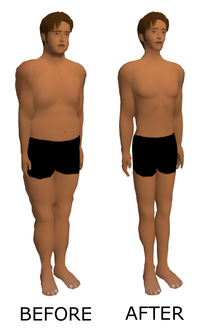
Photo from wikipedia
Laparoscopic Roux-en-Y gastric bypass (LRYGB) is classic bariatric procedure with long-term safety and efficacy. However, no studies have focused on predicting long-term weight loss after LRYGB in Chinese patients with… Click to show full abstract
Laparoscopic Roux-en-Y gastric bypass (LRYGB) is classic bariatric procedure with long-term safety and efficacy. However, no studies have focused on predicting long-term weight loss after LRYGB in Chinese patients with body mass index (BMI) ≥ 32.5 kg/m2. To explore the relationship between initial and long-term weight loss after LRYGB in patients with BMI ≥ 32.5 kg/m2. All patients were followed-up to evaluate BMI, percentage of excess weight loss (%EWL), and comorbidities. Linear and logistic regression were performed to assess the relationship between initial and long-term weight loss. Receiver operating characteristic curve was used to determine optimal cutoff value. We enrolled 104 patients. The median preoperative BMI was 41.44 (37.92–47.53) kg/m2. %EWL ≥ 50% at 5 years was considered as successful weight loss, and 75.00% of the patients successfully lost weight. The cure rates of hypertension, hyperlipidemia, and type 2 diabetes mellitus at 1 year were 84.38%, 33.93%, and 60.82%, respectively. %EWL at 6 months and 5 years were positively correlated and its relationship could be described by following linear equation: %EWL5 years = 43.934 + 0.356 × %EWL6 months (P < .001; r2 = 0.166). The best cutoff %EWL at 6 months after LRYGB to predict 5-year successful weight loss was 63.93% (sensitivity, 53.85%; specificity, 84.62%; area under the curve (AUC) = 0.671). In Chinese patients with BMI ≥ 32.5 kg/m2, %EWL at 6 months and 5 years were positively correlated and %EWL at 5 years could be calculated by following linear equation: %EWL5 years = 43.934 + 0.356 × %EWL6 months.
Journal Title: Medicine
Year Published: 2023
Link to full text (if available)
Share on Social Media: Sign Up to like & get
recommendations!